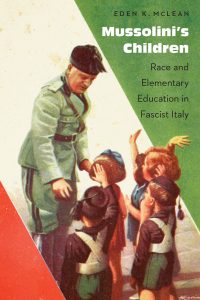Mussolini’s Children traces how, from 1922 on, Benito Mussolini and his Fascist State used the elementary school system – the scuola elementare, generally intended for ages six to eleven – and the language of racial superiority to forge “the New Italians of a New Italy” (p. 2). The system was tasked with “instill[ing] […] faith in the power of Fascism, faith in the unity of the fatherland, faith in the supremacy of the race” (p. 162).
The book is divided into four parts, corresponding to the years 1922-1929, 1929-1934, 1934-1938, and 1938-1940, respectively, and ending with Italy’s entry into the Second World War; the concluding chapter goes on to provide a sketch of subsequent developments until 1945.
The author has studied numerous collections of documents kept in the Archivio centrale dello Stato, as well as official bulletins, specialized magazines, books, and pictorial and other documentary materials, including schoolbook covers, from those years. She has also examined an impressive array of secondary sources. Of these latter, however, some important documentary works on the history of racism in schools and others on the implementation of racist practices at the local level following the promulgation of the Fascist Manifesto of Race and the anti-Semitic laws of 19381 seem to have been left out. Sadly, even in Italy to date these sources are little known.
According to Eden K. McLean, the Fascist regime “developed an increasingly totalitarian education system that worked in tandem with – and lay at the heart of – a comprehensive and ever more exclusionary racial campaign” (p. 2). In her view, the process Mussolini wanted to set in motion of bringing up new, strong, racially pure generations possessed of a racial and racist consciousness was inclusive of all other major political, cultural, and economic Fascist policies affecting youth. Thus even the education reform introduced in 1923 by Giovanni Gentile, with all the empowerment which it ensured for the Catholic religion, was in fact designed to further Fascist racist education (p. 36). In the same way, campaigns promoting nationalism, militarism, pronatalism and public health, language homogenization, extended colonialism, and imperialism, among others, although clearly defined each within its separate realm, were also all an integral part of the effort to create a racist Italy beginning with a racist youth. The author seems to be absolutely certain of this, without considering interpretations advanced by other scholars.
McLean details the development stages of Fascist policies concerning youth and education, consistently highlighting legislation that directly or indirectly affected children both within and beyond school walls, including measures targeting the little-known institution of “rural schools.” She points to speeches by Mussolini and his ministers, showing the link between them and the content of schoolbooks and specialized publications; she also draws attention to the gradual disappearance of female role models, along with other developments indicative of the entrenchment of the new regime’s ideology. The book provides an eloquent portrayal of the totalitarian tactics used by Mussolini and the Fascist State to manipulate children and the intensification of these tactics with time, comparing them with what the she calls “Western pedagogy.” Interestingly, fewer comparisons are made with the Nazi approach to education, despite the fact that this latter had considerably greater similarity to the Italian system that did the “Western.”
The Fascist Manifesto of Race and the enactment of “legal anti-Semitism” with the promulgation of Italy’s racial laws in 1938 are prominent in their chronologically designated section of McLean’s work. Several pages are devoted to the former, focusing attention on its new aspects. In terms of significance, however, McLean’s view is that the Manifesto was not decisive.: despite the introduction of the biological criterion, and “despite the new ‘scientific’ thrust of language, […] [it] did not prove to be a remarkable departure from the foundational concepts of race” (p. 182). The author goes on to a limited discussion of the anti-Jewish legislation, without, however, attempting to situate it within the larger historical context of Jews and of anti-Semitism in Italy or in Europe overall. As she sees it, the legislation “was part of a much larger network of ideas, policies, and actions regarding the Italian race and nation-state” (p. 7). She does take up the interpretation offered by a significant number of scholars, explaining that she disagrees that the Manifesto marked “the beginning of the domestic Fascist racial campaign because of these substantial legal developments” (p. 186).
Readers may find it hard to subscribe to some of the evaluations in McLean’s study of these two key developments of 1938. Leaving in-depth analysis for a different, more extensive discussion, suffice it at this juncture to note that in Fascist Italy racism and anti-Semitism were distinct, albeit interrelated phenomena; the ushering in of anti-Semitism as a state policy marked a turning point, not a moment of tortuous continuity with earlier years. The decision to adopt a biologically racist approach was not the only defining element of this momentous turn. The composition of the Fascist Manifesto of Race and forcing it upon the public did not constitute a powerful crescendo, but marked the starting point of the transformation of Italy into a racist state.
With this said, we need to draw attention to the fact that Eden K. McLean has provided us with an excellently thorough presentation of the way in which the children of Mussolini’s Italy were subjected to increasingly racist indoctrination.
